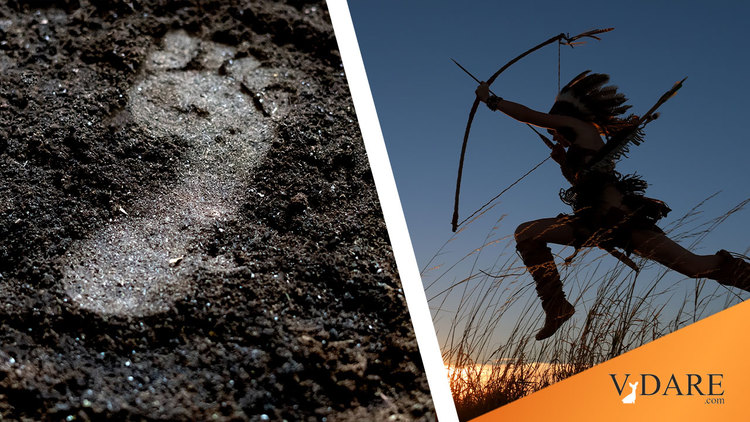
By Steve Sailer
09/25/2021
Earlier: Why Did American Indians Go From The Copper Age Back To The Stone Age?
From The New York Times science section:
Ancient Footprints Push Back Date of Human Arrival in the Americas
Human footprints found in New Mexico are about 23,000 years old, a study reported, suggesting that people may have arrived long before the Ice Age’s glaciers melted.
By Carl Zimmer
Sept. 23, 2021Ancient human footprints preserved in the ground across the White Sands National Park in New Mexico are astonishingly old, scientists reported on Thursday, dating back about 23,000 years to the Ice Age.
… For decades, many archaeologists have maintained that humans spread across North and South America only at the end of the last ice age. They pointed to the oldest known tools, including spear tips, scrapers and needles, dating back about 13,000 years. The technology was known as Clovis, named for the town of Clovis, N.M., where some of these first instruments came to light.
The age of the Clovis tools lined up neatly with the retreat of the glaciers. That alignment bolstered a scenario in which Siberian hunter-gatherers moved into Alaska during the Ice Age, where they lived for generations until ice-free corridors opened and allowed them to expand southward.
We know the Clovis era population of 13,000 years ago was a very big deal because the Americas’ mega-fauna, such as woolly mammoths and sabre-tooth tigers, soon began to die off and go extinct. Rather than blame it on the ancestors of the American Indians eating them, it’s polite to blame the extinctions on climate change: you see, at the end of Ice Ages, the weather got nicer, so all the giant beasts just died from joy, or something. For example, the La Brea Tarpits museum explains that during the Ice Age, the climate of Los Angeles was like the Monterey Peninsula south of San Francisco today, so of course the giant beasts all just died (because how could they possibly walk all the way to the Monterey Peninsula?).
The study at White Sands now adds a new line of evidence for an early arrival: Instead of tools, the researchers have found footprints.
The footprints were first discovered in 2009 by David Bustos, the park’s resource program manager. Over the years, he has brought in an international team of scientists to help make sense of the finds.
Together, they have found thousands of human footprints across 80,000 acres of the park. One path was made by someone walking in a straight line for a mile and a half. Another shows a mother setting her baby down on the ground. Other tracks were made by children. …
Mammoths, dire wolves, camels and other animals left footprints as well. One set of prints showed a giant sloth avoiding a group of people, demonstrating that they were in close company. …
The scientists dug a trench near one cluster of human and animal footprints to get a tighter estimate of their age. On the side of the trench, they could see layer after layer of sediment. Carefully mapping the surrounding ground, they were able to trace the footprints of humans and animals to six layers in the trench, interspersed with eleven seed beds.
The researchers collected ditch grass seeds from each bed and measured their carbon. These measurements confirmed the initial results: The oldest footprints at the site — left by an adult human and a mammoth — were located below a seed bed dating back about 22,800 years.
In other words, the people who left the footprints walked around White Sands about 10,000 years before the Clovis people. The youngest footprints, the researchers estimated, dated to about 21,130 years ago. That meant that people lived or regularly visited the lake for about 2,000 years.
… Dr. Potter praised the White Sands team for their care in the new study, saying that it is the strongest case yet made for people in the Americas before 16,000 years ago. But he would feel more confident in the extraordinary age of the prints, he said, if there were other lines of evidence beyond the ditch grass seeds. The seeds could have absorbed older carbon from the lake water, making them seem older than they really are.
So, don’t take this as for sure.
But if true, it would suggest that somebody got here long before the proto-American Indians of Clovis. Interestingly, they didn’t wipe out much of the mega-fauna. Maybe they went more or less extinct? If so, did they die off on their own or did the proto-Indians kill them?
And how closely related were they to subsequent American Indians? Perhaps the same people kept going back and forth from Siberia to Alaska and occasionally getting past the glacier barrier that cut off Alaska from the rest of the Americas. But 10,000 years is a long time to retain genetic continuity in Eurasia (as opposed to on an island).
A few years ago, a curious discovery was made among a few tribes deep in the Amazon: a small percentage of their DNA didn’t look like that of any other Amerindians. The researchers compared it to the DNA of Andaman Islanders in the Indian Ocean. Nobody really has a clue about this finding, but maybe they are descended in slight part from the mysterious White Sands people?
This is a content archive of VDARE.com, which Letitia James forced off of the Internet using lawfare.